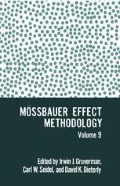Abstract
Although the selective excitation double Mössbauer effect (SEDM) has been known for some time,1, 2, 3 it has only recently been applied to the study of solid state problems4. The reason for the delay is that the necessary theory and computational techniques had to be developed to handle the case of thick specimens which are required for an adequate counting rate.
This work was supported by the National Science Foundation under Grant No. GH-39137.
Access this chapter
Tax calculation will be finalised at checkout
Purchases are for personal use only
Preview
Unable to display preview. Download preview PDF.
References
A. N. Artemev, G.V. Smirov, E.P. Stepanov, Sov. Phys. JETP 27, 547 (1968).
W. Meisel, Monatsber, Deutschen Akd. Wiss. Berlin Ger. 11, 355 (1969).
N. D. Heiman, J. C. Walker, and L. Pfeiffer, Phys. Rev. 184, 281 (1969), and “Mössbauer Effect Methodology”, Vol. 6, I. J. Gruverman, ed. (Plenum Press, New York, 1971).
B. Balko and G. R. Hoy, Phys. Letters, (1974).
W. Heitler, Quantum Theory of Radiation (Clarendon Press, Oxford, 1954).
A. J. F. Boyle and H. E. Hall, Repts. Progr. in Phys. 25, 441 (1962).
P. Debrunner and R. J. Morrison, Rev. Sci. Instr. 36, 145 (1965).
B. Balko and G. R. Hoy, submitted for publication.
P. B. Moon, Proc. Phys. Soc. A63, 80 (1950).
P. J. Black, D. E. Evans, and D. A. O’Connor, Proc. Roy. Soc. (London) A 270, 168 (1962).
P. J. Black, G. Longworth, and D. A. O’Connor, Proc. Phys. Soc. 83, 937 (1964).
S. L. Ruby and J. M. Hicks, Rev. Sci. Instr. 33, 27 (1962).
Yu Kagan, A. M. Afanasév, and I. P. Perstnev, Sov. Phys. JETP 27, 819 (1968) [Zh. Eksp. Theor. Fiz. 54, 1530 (1968)].
P. B. Moon, Proc. Roy. Soc. A263, 309 (1961).
M. Blume, in Hyperfine Structure and Nuclear Radiations, E. Matthias and D. A. Shirley Eds. (North Holland Publishers, Amsterdam, 1968) page 911.
P.W. Anderson, J. Phys. Soc. Japan 9, 316 (1954).
A. Abragam, Nuclear Magnetic Resonance (Oxford Univ. Press, London, 1961).
A. Paupolis, Probability, Random Variables and Stochastic Processes, (McGraw-Hill Co., 1965).
P. J. Flanders and J. P. Remeika, Phil. Mag. 11, 1271 (1965).
P. Imbert and A. Gerard, Compt. Rend. 257, 1054 (1963).
S. T. Lin, Phys. Rev. 116, 1447 (1959).
R. C. Liebermann and S. K. Banerjee, J. Appl. Phys. 41, 1414 (1970).
S. Foner and S. J. Williamson, J. Appl. Phys. 36, 1154 (1965).
J. O. Artman, J. C. Murphy, and S. Foner, Phys. Rev. 138, A912 (1965).
F. Van der Woude, Phys. Stat. Solidi 17, 417 (1966).
H. H. Wickmann, Mössbauer Effect Methodology, Vol. 2, I. J. Gruverman, ed. (Plenum Press, N.Y. 1968), p. 316.
W. Kündig and R. S. Hargrove, Solid State Commun. 7, 223 (1969).
F. Van der Woude and A. J. Dekker, Phys. Stat. Sol. 13, 181 (1966).
H. H. Wickmann, M. P. Klein, and D. A. Shirley, Phys. Rev. 152, 345 (1966).
M. J. Clauser and M. Blume, Phys. Rev. B3, 583 (1971).
Author information
Authors and Affiliations
Editor information
Editors and Affiliations
Rights and permissions
Copyright information
© 1974 New England Nuclear Corporation
About this chapter
Cite this chapter
Balko, B., Hoy, G.R. (1974). Selective Excitation Double Mössbauer Spectroscopy. In: Gruverman, I.J., Seidel, C.W., Dieterly, D.K. (eds) Mössbauer Effect Methodology. Springer, Boston, MA. https://doi.org/10.1007/978-1-4684-0937-6_16
Download citation
DOI: https://doi.org/10.1007/978-1-4684-0937-6_16
Publisher Name: Springer, Boston, MA
Print ISBN: 978-1-4684-0939-0
Online ISBN: 978-1-4684-0937-6
eBook Packages: Springer Book Archive

